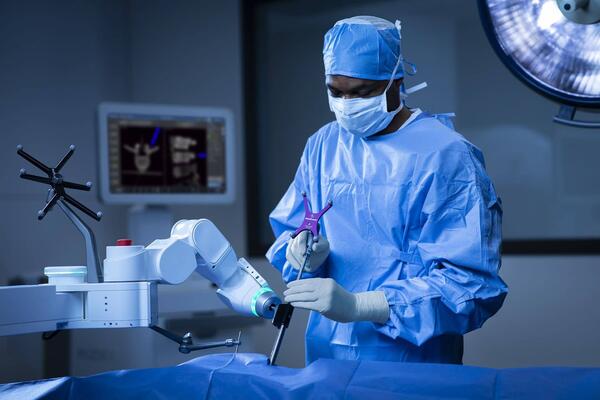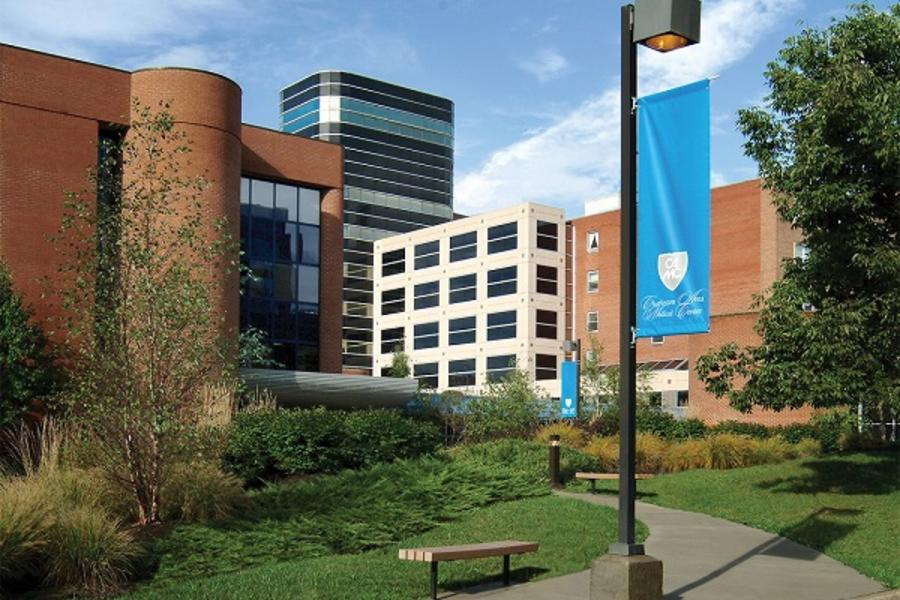Our Approach
The Mazor X Stealth™ Edition is a robotic guidance system that allows surgeons at CAMC to perform less invasive spine surgeries using 3D software and GPS capabilities, bringing a greater level of predictability and precision to the operating room.
“This technology allows us to create a surgical blueprint for each patient before we ever go into the operating room,” said John Orphanos, MD, neurosurgeon/spine surgeon. “We literally create a map of your spine and plan each step of your surgery that’s specific to your anatomy just like you use GPS to plan a route when you travel.”
During the procedure, the surgeon guides surgical tools in place using the system’s robotic arm and 3D optical tracking camera. This visualization system allows surgeons to more accurately place hardware and implants into the spine through micro-incisions while simultaneously using real-time imaging to ensure the plan is being carried out as desired.
This technology brings an entirely new level of accuracy to delicate back surgeries,” Orphanos said. “For patients, it means less pain, less time under anesthesia, less radiation exposure, smaller incisions, shorter recovery time, and fewer complications, which all lead to a faster recovery and return to daily activities.”
CAMC is the first in southern West Virginia to offer robotic technology for spine surgery.
Mazor X™ assists surgeons in the treatment of many spine conditions such as degenerative disc disease, scoliosis (curvature) of the spine, herniated disc, spondylolisthesis, stenosis and vertebral fractures.
Living with back pain can be debilitating, and recovering from spine surgery was once a long process,” said Lana Christiano, MD, neurosurgeon/spine surgeon. “By combining robotics and navigation, we are excited to offer patients a better solution that reduces their recovery time after surgery and greatly improves their quality of life.”
Your surgeon will select the best treatment for your specific condition. Based on your CT-scan, your surgeon will use the system's advanced 3D planning software to plan the optimal surgery customized for your anatomy and diagnosis. Once in the operating room, Mazor X guides your surgeon precisely to the preplanned anatomical location where intervention is necessary.
The Mazor Robotics system is not independent and does not cut or perform any action on your body. Only your surgeon performs the required procedures such as placing implants. Your surgeon is in full control of the system at all times. Also, at any stage, your surgeon can decide to continue without the assistance of Mazor X.
In open surgery, the spine is exposed through a large incision to allow a full, direct field-of-view and access to the surgeon’s hand and tools.
In minimally-invasive surgery (MIS), the surgeon makes small skin incisions to allow visualization of the operating field by retracting the tissues beneath the skin and exposing the spine. To compensate for this limited field-of-view, surgeons use fluoroscopy (X-ray) images to view their progress. Yet, even with imaging, comparative studies demonstrate that MIS accuracy is lower than in open surgeries (which offer a better, direct field-of-view). So, there is usually a clinical trade-off between accuracy versus the advantages of MIS.
With Mazor Robotics, spine surgery patients benefit from high levels of accuracy and the advantages of minimally-invasive surgery. Independent scientific research has shown that minimally-invasive surgery lowers complication rates, reduces postoperative pain, and aides in faster recovery with a quicker return to daily activities when compared to open, freehand surgeries.
Worldwide, Mazor technology has been used in over 250,000 implants and approximately 36,000 cases.
Mazor Robotics' clinically-proven technology has been used in thousands of surgeries worldwide, strictly adhere to international standards, and have received FDA clearance in the United States and Europe.
Which CAMC surgeons use Mazor X?
The following surgeons have been specially trained to use the Mazor X robotic guidance system for spine surgery:



